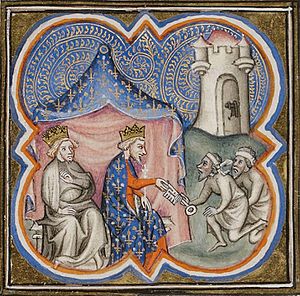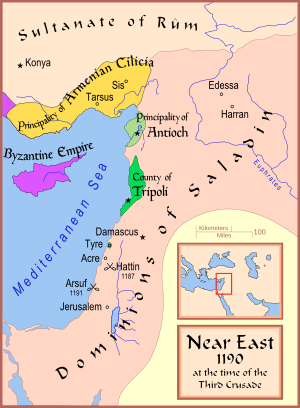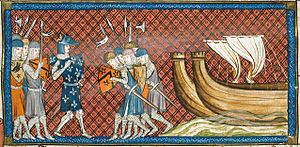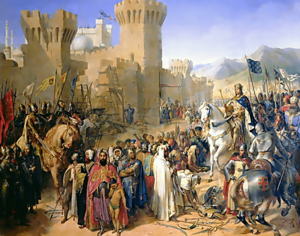Siege of Acre (1189–1191) facts for kids
Quick facts for kids Siege of Acre |
|||||||
|---|---|---|---|---|---|---|---|
| Part of the Third Crusade | |||||||
 Manuscript depiction of Acre surrendering to Richard I of England and Philip II of France (late 14th century) |
|||||||
|
|||||||
| Belligerents | |||||||
|
|
|||||||
| Commanders and leaders | |||||||
|
|||||||
| Strength | |||||||
| Total: 59,000 men 102 ships Initially: 7,000–10,000 men End: 25,000 men 11 trebuchets |
45,000–50,000 men
|
||||||
| Casualties and losses | |||||||
| 19,000 dead |
Garrison: 5,000–10,000 dead Relief force: heavy |
||||||
The Siege of Acre was a major battle during the Third Crusade. It was the first big attack by Guy of Lusignan, the King of Jerusalem, against Saladin, the powerful Muslim leader. The siege lasted a very long time, from August 1189 to July 1191. Acre was a port city, so both sides could get supplies by sea. This made the battle last longer. In the end, the Crusaders won, which was a big defeat for Saladin. It also helped the Crusader states survive for a while longer.
Contents
Why the Siege of Acre Happened
Saladin's Rise to Power
For a long time, Egypt was ruled by the Fatimid Caliphate. This group was different from the main Muslim rulers in Baghdad. Over time, Egypt's power weakened due to internal struggles. In 1163, a former leader from Egypt, Shawar, asked for help from Nur ad-Din, a powerful Muslim ruler in Damascus.
Nur ad-Din sent his general, Shirkuh, to Egypt. Shirkuh helped Shawar regain his position. But Shawar then allied with the Crusaders. When the Crusaders attacked, Shawar again asked Nur ad-Din for help. Shirkuh returned, defeated the Crusaders, and became the new leader of Egypt.
Shirkuh died soon after, and his nephew, Yusuf ibn Ayyub, took over. He is better known as Saladin. Saladin quickly became a very strong leader. He united many Muslim lands, from Egypt to Syria.
The Battle of Hattin and Jerusalem's Fall
Saladin became known as a champion of Islam. He began to fight more against the Christian Crusaders. Guy of Lusignan, the King of Jerusalem, gathered a large army to stop him. However, Saladin tricked Guy's army into a dry, waterless area.
In 1187, Saladin's forces completely defeated the Crusaders at the Battle of Hattin. This was a huge loss for the Christians. After this victory, Saladin quickly captured many cities in Palestine, including Jerusalem. The fall of Jerusalem shocked Europe.
Pope Urban III was very sad when he heard the news. A new Pope, Gregory VIII, called for a new Crusade to take back Jerusalem. This became known as the Third Crusade. Many European leaders, like Emperor Frederick Barbarossa, set out for the Holy Land. Sadly, Frederick drowned on his way.
Tyre and Guy's Plan
After the Battle of Hattin, the city of Tyre was one of the few Crusader strongholds left. Conrad of Montferrat successfully defended Tyre against Saladin's attacks. Saladin tried to make a deal to get Tyre, even releasing King Guy, who he had captured at Hattin.
When Guy arrived at Tyre, Conrad would not let him in. Conrad believed he was in charge until the European kings arrived. Guy then set up his camp outside Tyre. He needed a strong base to fight Saladin. Since he couldn't get Tyre, he decided to attack Acre, a city about 50 km (31 miles) south. Acre was an important port and a major supply center for Saladin.
Saladin knew Acre was important. He decided to make its defenses stronger. In 1189, more Crusader ships and knights arrived in the Holy Land, joining Guy's forces. Guy convinced these new arrivals to support his plan to attack Acre. So, Guy and his allies marched to Acre, while their ships sailed along the coast.
Starting the Siege of Acre
Acre was built on a small piece of land sticking out into the sea. It had strong walls and towers. Saladin had many soldiers defending Acre, thousands of them. Guy's army was smaller, with about 7,000 to 9,000 foot soldiers and 400 to 700 knights. The Crusaders needed more help from Europe.
Guy first tried to surprise the city's defenders, but it didn't work. So, he set up his camp outside the city walls and waited for more help. Soon, more ships arrived from Denmark, France, and Germany. Leaders like Louis III, Landgrave of Thuringia, and Leopold V of Austria joined the siege. Even Armenian troops came to help.
When Saladin heard about this, he brought his own army to Acre. He attacked Guy's camp on September 15, but he couldn't break through.
The Battle of Acre
On October 4, Saladin moved his army to face Guy's camp. By this time, the Crusader army had grown to 30,000 foot soldiers and 2,000 cavalry. A Christian fleet of over 100 ships blocked the city from the sea. Saladin's army was made up of soldiers from many different Muslim regions.
The Muslim army formed a semicircle around the Crusaders, facing Acre. The Crusaders were in the middle. The battle began with a fight between the Knights Templar and Saladin's forces. The Crusaders pushed back the enemy. The Christian center also advanced well, using crossbows to prepare the way for their knights. Saladin's army began to retreat.
However, the victorious Crusaders started to spread out and take plunder. Saladin quickly gathered his men and sent his light cavalry to attack them. The Crusaders were caught off guard and suffered heavy losses. The Acre garrison also attacked the Christian camp from behind. Many Crusaders were killed, including Gerard de Ridefort, the Grand Master of the Templars. In the end, the Crusaders managed to push back Saladin's army. But both sides lost many soldiers.
The Double Siege Begins
As autumn arrived, more Crusaders came from Europe. This allowed Guy to completely surround Acre by land. News also spread that Emperor Frederick Barbarossa was on his way. This boosted the Crusaders' spirits. Saladin also brought in more troops. Soon, both the city of Acre and the Crusader camp were surrounded by Saladin's army. It was a "double siege."
On October 30, 50 Muslim ships managed to break through the Christian blockade. They brought 10,000 new soldiers, food, and weapons into Acre. In December, an Egyptian fleet arrived to control the port. In March 1190, Conrad of Montferrat brought more supplies for the Crusaders. They used these to build siege machines, but these were lost in an attack on the city.
On May 20, Saladin launched a big attack on the Christian camp. It lasted eight days, but the Crusaders held their ground. More French Crusaders arrived over the summer. In October, Frederick VI, Duke of Swabia arrived with the rest of his father's army. English Crusaders also came. The Christians managed to open a path to Haifa, which helped them get more food.
Hardship and Leadership Changes
Life became very hard for both the people inside Acre and the Crusaders outside. Food was scarce, and the water became dirty. Diseases spread quickly. Many leaders got sick and some died.
In October, Guy's wife, Queen Sibylla, died. Her death meant Guy no longer had a strong claim to the throne of Jerusalem. The rightful heir was Sibylla's half-sister, Isabella I of Jerusalem. The Crusader leaders wanted to get rid of Guy. They arranged for Isabella to marry Conrad of Montferrat. This caused a lot of arguments about who should be king.
The winter of 1190-1191 was very difficult. Acre had 20,000 defenders. In the Christian camp, more leaders died from disease. On December 31, another attempt to break the walls failed. On January 6, parts of the walls collapsed, leading to more fighting. On February 13, Saladin managed to get through the Christian lines and send fresh soldiers into Acre. This saved the city's tired defenders.
In March, the weather improved, and ships could bring supplies again. Leopold V, Duke of Austria arrived and took charge of the Christian forces. Then, even bigger news arrived: King Richard the Lionheart and King Philip Augustus were on their way with their armies. Saladin's best chance to win was gone.
The Kings Arrive at Acre
King Philip arrived on April 20. King Richard arrived on June 8, after conquering Cyprus on his way. Richard brought 100 English ships and 8,000 men. Philip had already started building siege engines, like the trebuchet. With these two powerful kings, the Crusaders now had much stronger leadership.
Richard tried to meet with Saladin, and they agreed to a three-day ceasefire. But both Richard and Philip became ill, so the meeting didn't happen.
Philip wanted to attack Acre right away. Richard was still sick and waiting for more of his men and siege equipment. Philip continued building siege machines. On June 17, he attacked Acre with ballistas and other engines. The defenders inside Acre made a lot of noise and smoke to signal Saladin's army outside for help.
The siege machines made holes in Acre's walls. But each time, Saladin's army attacked the Crusaders, giving the defenders time to repair the damage. On July 2, Richard used his own powerful siege engines, including two huge mangonels named "God's Own Catapult" and "Bad Neighbour."
On July 3, another large hole was made in the walls, but the Christian attack was pushed back. On July 4, the city offered to surrender, but Richard refused their terms. Saladin did not launch a big attack this time. On July 7, the city sent a final message to Saladin, saying they would surrender if he didn't help.
On July 11, there was one last battle. On July 12, Acre offered to surrender again, and this time the Crusaders accepted. Conrad of Montferrat, who had left Acre because of the arguments over the kingship, was called back to negotiate. Saladin agreed to the surrender. The Crusaders entered the city, and the Muslim soldiers inside were taken prisoner. The flags of Jerusalem, France, England, and Austria were raised over Acre.
Soon after, Leopold of Austria left Acre. He had argued with Richard because he felt he deserved the same respect as Philip and Richard. Philip also went home on July 31 to deal with matters in France. Richard was left in charge of the Crusader forces.
What Happened to the Prisoners
Richard and Saladin still had to finalize the surrender terms. The Christians began to rebuild Acre's defenses. Saladin started collecting money to pay for the release of the captured soldiers. On August 11, Saladin made the first payment and prisoner exchange. But Richard refused it because some Christian nobles he wanted were not included. The exchange stopped, and talks failed.
Richard also insisted on getting the prisoners that Philip had left with Conrad. Conrad agreed, even though he didn't want to. On August 20, Richard felt Saladin had delayed too much. He ordered the execution of 2,700 Muslim prisoners from Acre's garrison.
Saladin responded by executing all the Christian prisoners he had captured. On August 22, Richard and his army left Acre, leaving it in the care of other Crusaders.
After the Siege
The capture of Acre and the executions changed Saladin's plans. He became more likely to destroy fortifications to prevent them from being captured by the Crusaders. He also focused on making Jerusalem's defenses stronger.
The Crusader army marched south along the coast, with Saladin's army following them. On September 7, they fought at the Battle of Arsuf, where Saladin was defeated. Richard captured Jaffa on September 10. However, he was unable to recapture Jerusalem. The argument over who should be King of Jerusalem was settled in April 1192, when Conrad of Montferrat was chosen. But he was killed just days later. Queen Isabella then quickly married Henry II of Champagne, Richard and Philip's nephew.
Meanwhile, Richard heard that his brother, John Lackland, was trying to take his throne in England. Richard made a peace treaty with Saladin. The Third Crusade ended when Richard left for England in October. He was later captured and imprisoned by Duke Leopold in Austria, but was eventually released after a large ransom was paid.
The Kingdom of Jerusalem was now safer, with its new capital at Acre. It controlled a narrow strip of land along the Mediterranean coast. This version of the Kingdom of Jerusalem lasted for another 100 years.
Images for kids
-
Richard the Lionheart on his way to Jerusalem, James William Glass (1850)





